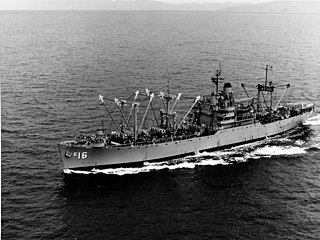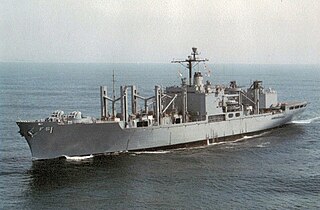
The sixth USS Somers was a Forrest Sherman-class destroyer when her keel was laid down at the Bath Iron Works on 4 March 1958, she was launched on 30 May, and commissioned on 3 April 1959.

The second USS Pyro (AE–24), an ammunition ship, was laid down 21 October 1957 by Bethlehem-Sparrows Point Shipyard, Inc., Sparrows Point, Maryland; launched 5 November 1958; sponsored by Mrs. Stuart H. Ingersoll; and commissioned 24 July 1959 at Norfolk Naval Shipyard, Norfolk, Va.

USS Mount Katmai (AE-16) was a Mount Hood-class ammunition ship of the United States Navy, that saw service in the Korean War and the Vietnam War.

USS Mazama (AE‑9) was a US Navy ammunition ship laid down 14 April 1942 by the Tampa Shipbuilding Co., Tampa, Fla.; launched 15 August 1943; sponsored by Mrs. Edward V. Rickenbacker; and commissioned 10 March 1944. She was named for Mount Mazama, a collapsed volcano in the Cascade Range in Oregon whose caldera is now occupied by Crater Lake.

USS Mauna Loa (AE-8) an ammunition ship in service with the United States Navy. She was commissioned from 1944 to 1947, and recommissioned between 1955 and 1958 and from 1960 to 1969. Mauna Loa was finally scrapped in 1984.

USS Rainier (AE-5), the second US Navy vessel named after Mount Rainier, was laid down on 14 May 1940 by the Tampa Shipbuilding Co., Tampa, Fla., as Rainbow ; launched 1 March 1941; sponsored by Mrs. Robert E. Anderson; transferred to the US Navy on 16 April 1941; converted for use as an ammunition auxiliary; and commissioned as Rainier (AE-5) on 21 December 1941 at Norfolk, Va..

USS Wrangell (AE-12) was laid down under a Maritime Commission contract as SS Midnight during February 1944 at Wilmington, North Carolina, by the North Carolina Shipbuilding Company; launched on 14 April 1944; sponsored by Mrs. G. T. Cambell; delivered to the Navy, incomplete, on 28 May 1944; moved to Hampton Roads; converted to an ammunition ship by the Norfolk Shipbuilding and Drydock Co.; and commissioned on 10 October 1944 at the Norfolk Navy Yard.

The fourth USS Vesuvius (AE-15) was laid down under a Maritime Commission contract by the North Carolina Shipbuilding Company, Wilmington, N.C.; launched on 26 May 1944; acquired by the United States Navy on 4 July 1944; and commissioned on 16 January 1945.

USS Haleakala (AE-25) was a Nitro-class ammunition ship of the United States Navy in service from 1959 to 1993.

USS Ajax (AR-6), in service 1943 to 1986, was the second Vulcan-class repair ship and the fourth ship in the United States Navy to bear the name. Laid down in 1941, launched in 1942 and commissioned in 1943, she was decommissioned in 1986 and finally sold for scrap. Ajax received four battle stars for Korean War service and five campaign stars for service in Vietnam.

USS Wichita (AOR-1) was the lead ship of the Wichita-class replenishment oilers. She was the second ship to be named for the city of Wichita, Kansas.

USS Shasta (AE-33) was a Kilauea-class replenishment ammunition ship of the United States Navy. She was named after Mount Shasta, a volcano in the Cascade Range in northern California. Shasta's mission was to support forward deployed aircraft carrier battle groups, which she accomplished through underway replenishment and vertical replenishment. Over three decades, Shasta and her crew took part in the Vietnam War, the Cold War, the Iran–Iraq War, Desert Shield/Operation Desert Storm, and numerous other actions.

USS Mars (AFS‑1), the third United States Navy ship to bear the name, was laid down by the National Steel and Shipbuilding Company in San Diego, California, on 5 May 1962; launched on 15 June 1963, sponsored by Mrs. Clyde Doyle, widow of Representative Clyde Doyle of California; and commissioned at Long Beach Naval Shipyard on 21 December 1963.

USS Graffias (AF-29), a Hyades-class stores ship, is the only ship of the United States Navy to have this name. The name Graffias is another name for the star Beta Scorpii in the constellation Scorpius.

USS Virgo (AKA-20) was an Andromeda class attack cargo ship of the United States Navy, named after the constellation Virgo. She was later converted to an ammunition ship and redesignated as (AE-30). She served as a commissioned ship for 22 years and 4 months.

USS Satyr (ARL-23) was one of 39 Achelous-class landing craft repair ships built for the United States Navy during World War II. Named for the Satyr, she was the only US Naval vessel to bear the name.

USS Wabash (AOR-5) was a Wichita-class replenishment oiler in the United States Navy from 1970 to 1994.

USS Caliente (AO-53) was a Cimarron-class fleet oiler built during World War II for the U.S. Navy. During her career in the Pacific Ocean, Caliente participated in World War II, the Korean War, and the Vietnam War. She was highly decorated for fulfilling her dangerous mission of carrying fuel into battle areas. She received ten battle stars for World War II, four for the Korean War and eight campaign stars for the Vietnam War.

USS White Plains (AFS-4) was a Mars-class combat stores ship in service with the United States Navy from 1968 to 1995. She was sunk as a target in 2002.

USS Ashtabula (AO-51) was a Cimarron-class fleet oiler of the United States Navy in service from 1943 to 1991. She survived three wars and was awarded eight battle stars for World War II service, four battle stars for Korean War service, and eight campaign stars for Vietnam War service. In the mid-1960s Ashtabula became the lead ship of her class, when she and seven other Cimarron-class oilers were lengthened ("jumboized"). She has been the only U.S. Navy ship to bear the name Ashtabula, after the City of Ashtabula which was named after the Ashtabula River in northeast Ohio.





















